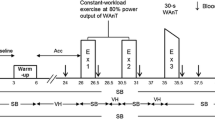Summary
To study the effects of exercise intensity and duration on excess postexercise oxygen consumption (EPOC), 8 men [age= 27.6 (SD 3.8) years, VO2max = 46.1 (SD 8.5) ml min−1 kg−1] performed four randomly assigned cycle-ergometer tests (20 min at 60% VO2max, 40 min at 60% VO2max, 20 min at 70% VO2max, and 40 min at 70% VO2max). O2 uptake, heart rate and rectal temperature were measured before, during, and for 1 h following the exercise tests. Blood for plasma lactate measurements was obtained via cannulae before, and at selected times, during and following exercise. VO2 rapidly declined to preexercise levels following each of the four testing sessions, and there were no differences in EPOC between the sessions. Blood lactate and rectal temperature increased (P<0.05) with exercise, but had returned to preexercise levels by 40 min of recovery. The results indicate that VO2 returned to resting levels within 40 min after the end of exercise, regardless of the intensity (60% and 70% VO2max or duration (20 min and 40 min) of the exercise, in men with a moderate aerobic fitness level.
Similar content being viewed by others
References
Bahr R, Ingnes O, Vaage O, Sejersted OM, Newsholme EA (1987) Effect of duration of exercise on excess postexercise O2 consumption. J Appl Physiol 62:485–490
Borg G (1961) Perceived exertion in relation to physical workload and pulse rate. K Fysiogr Sallsk Lund Forh 31:105–115
Brehm BA, Gutin B (1986) Recovery energy expenditure for steady state exercise in runners and nonexercisers. Med Sci Sports Exerc 18:205–210
Chad KE, Quigley BM (1991) Exercise intensity: effects on postexercise O2 uptake in trained and untrained women. J Appl Physiol 70:1713–1719
Chad KE, Wenger HA (1985) The effects of duration and intensity on the exercise and post-exercise metabolic rate. Aust J Sci Med Sport 17:14–18
Dill DB, Costill DL (1974) Calculation of percentage changes in volume of blood, plasma and red cells in dehydration. J Appl Physiol 37:247–248
Gaesser GA, Brooks GA (1984) Metabolic basis of postexercise oxygen consumption: a review. Med Sci Sports Exerc 16:29–43
Girandola RA, Katch FI (1973) Effects of physical conditioning on changes in exercise and recovery O2 uptake and efficiency during constant-load ergometer exercise. Med Sci Sports 5:242–247
Gore CJ, Withers RT (1990a) The effect of exercise intensity and duration on the oxygen deficit and excess post-exercise oxygen consumption. Eur J Appl Physiol 60:169–174
Gore CJ, Withers RT (1990b) Effect of exercise intensity and duration on postexercise metabolism. J Appl Physiol 68:2362–2368
Hagberg JM, Hickson RC, Ehsani AA, Holloszy JO (1980a) Faster adjustment to and recovery from submaximal exercise in the trained state. J Appl Physiol 48:218–224
Hagberg JM, Mullin JP, Nagle FJ (1980b) Effect of work intensity and duration on recovery O2. J Appl Physiol 48:540–544
Holloszy JO, Rennie MJ, Hickson RC, Conlee RK, Hagberg JM (1977) Physiological consequences of the biochemical adaptations to endurance exercise. Ann NY Acad Sci 301:440–450
Jackson AS, Pollock ML (1978) Generalized equations for predicting body density of men. Br J Nutr 40:497–504
Maehlum S, Grandmontagne M, Newsholme EA, Sejersted OM (1986) Magnitude and duration of excess postexercise oxygen consumption in healthy young subjects. Metabolism 35:425–429
Poehlman ET (1989) A review: exercise and its influence on resting energy metabolism in man. Med Sci Sports Exerc 21:515–525
Roth DA, Stanley WC, Brooks GA (1988) Induced lactacidemia does not affect postexercise O2 consumption. J Appl Physiol 65:1045–1049
Saltin B, Hermansen L (1966) Esophageal, rectal, and muscle temperature during exercise. J Appl Physiol 21:1757–1762
Sedlock DA, Fissinger JA, Melby CL (1989) Effect of exercise intensity and duration on postexercise energy expenditure. Med Sci Sports Exerc 21:662–666
Thoden JS, MacDougall JD, Wilson BA (1982) Testing aerobic power. In: MacDougall JD, Wenger HA, Green HJ (eds) Physiological testing of the elite athlete. Mutual Press, Canada, pp 39–60
Author information
Authors and Affiliations
Rights and permissions
About this article
Cite this article
Maresh, C.M., Abraham, A., De Souza, M.J. et al. Oxygen consumption following exercise of moderate intensity and duration. Europ. J. Appl. Physiol. 65, 421–426 (1992). https://doi.org/10.1007/BF00243508
Accepted:
Issue Date:
DOI: https://doi.org/10.1007/BF00243508




